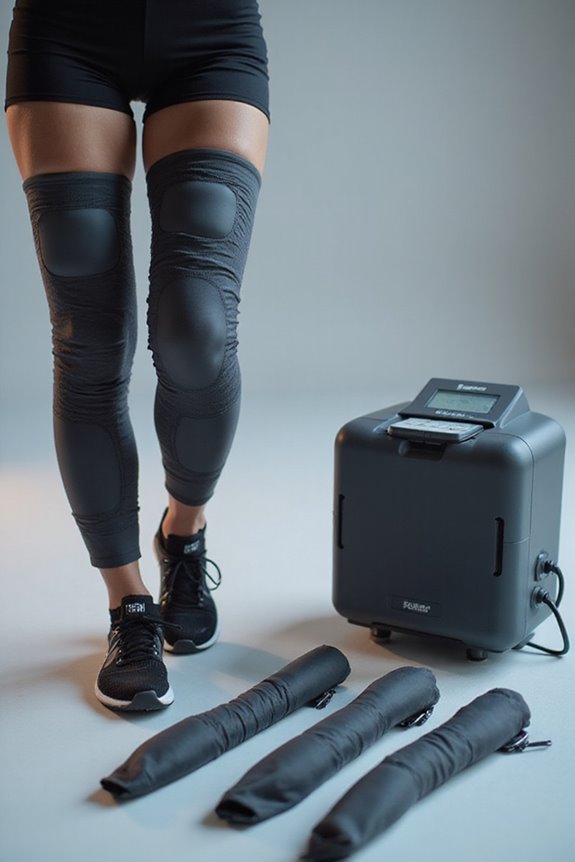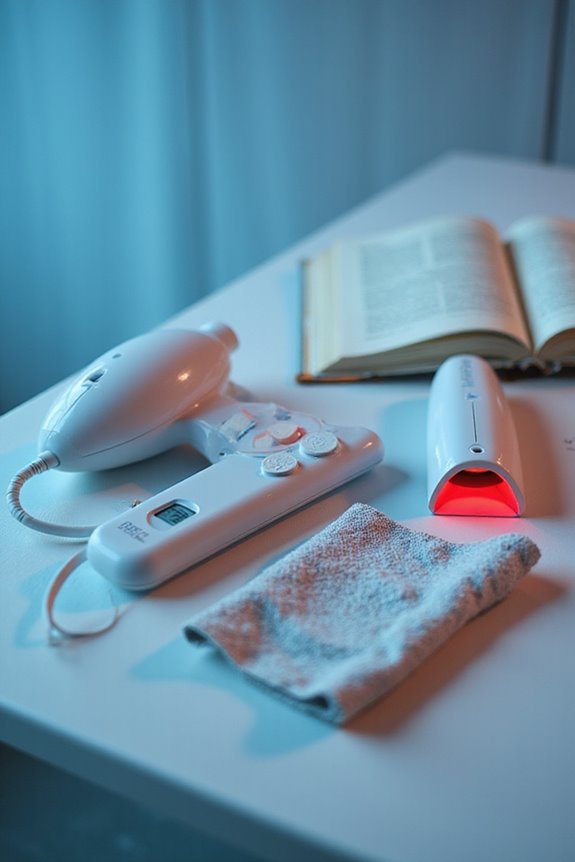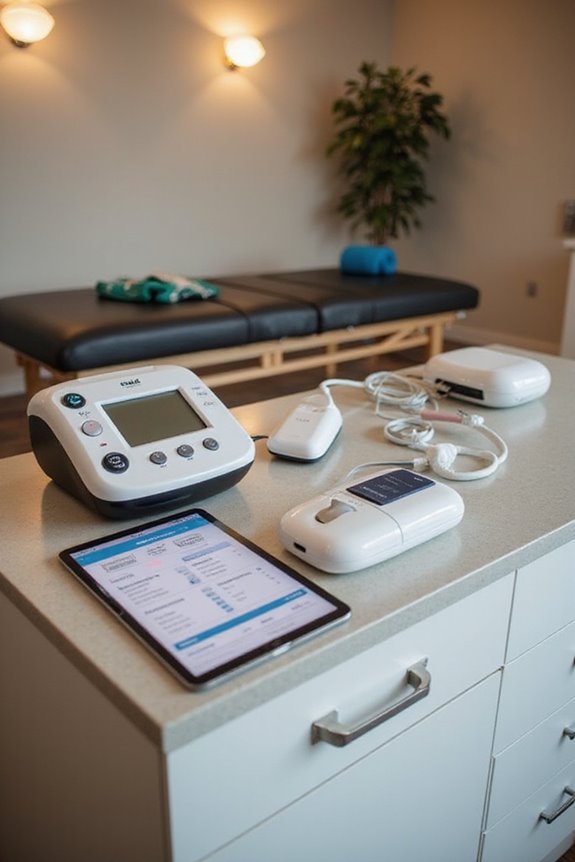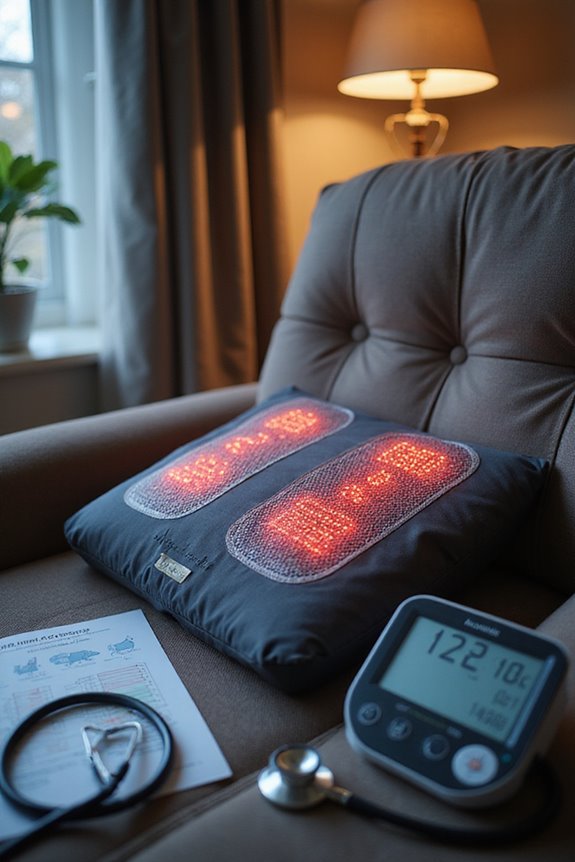TENS devices are classified as FDA-approved medical devices within the Class II category. This classification indicates that these devices have met specific safety and efficacy standards for pain management applications. The clearance process requires manufacturers to demonstrate substantial equivalence to already established devices. Safety protocols are enforced through strict performance standards and labeling requirements. Understanding these regulations can provide insight into the quality and trustworthiness of TENS devices available in the market. More information follows.
Key Takeaways
- TENS devices are classified as Class II medical devices and require FDA clearance for safety and efficacy.
- The FDA regulation number for TENS devices is 21 CFR 882.5890, which governs their approval.
- Manufacturers must demonstrate substantial equivalence to existing devices through the 510(k) premarket notification process.
- FDA clearance enhances consumer trust and ensures devices meet specified safety and effectiveness standards.
- High-quality, FDA-approved TENS devices are necessary for insurance reimbursement and professional stocking in pharmacies.
Overview of TENS Devices
TENS (Transcutaneous Electrical Nerve Stimulation) devices represent a category of medical technology designed for pain management through electrical nerve stimulation. These devices consist of an electrical pulse generator connected to electrodes placed on the skin.
TENS Device Benefits:
- Provides transient pain relief via nerve stimulation
- Can be customized for varying intensity levels, particularly in prescription models
- Some devices address neurological symptoms, such as hand tremors
TENS Device Limitations:
- Over-the-counter models may have preset safety limits, restricting effectiveness
- Efficacy varies based on individual response and device specifications
- Not all TENS devices have sufficient clinical efficacy evidence, which can influence consumer choice and trust.
FDA Clearance Process for Medical Devices

The FDA clearance process for medical devices is a critical regulatory framework that guarantees the safety and efficacy of devices entering the market. This process involves various regulatory pathways, influenced by device classification into Class I, II, and III based on risk.
- Class I devices often require minimal regulation and may be exempt from premarket notification.
- Class II devices typically necessitate a 510(k) premarket notification, demonstrating substantial equivalence to existing devices.
- Class III devices undergo the most rigorous Premarket Approval (PMA) process, requiring extensive clinical data.
Each pathway guarantees that devices meet safety standards before reaching consumers, fostering confidence in medical technology. Understanding these classifications and associated regulations is essential for manufacturers and healthcare providers alike.
Classification of TENS Devices
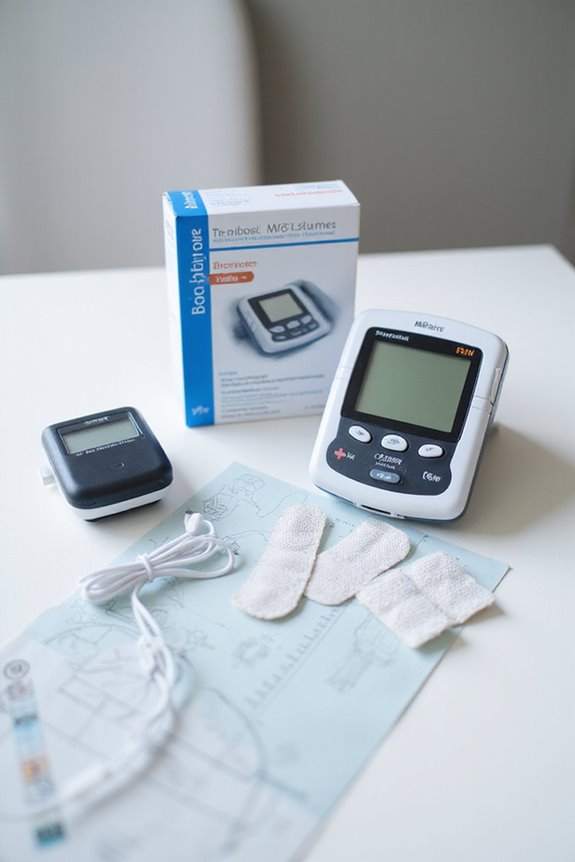
When examining the classification of Transcutaneous Electrical Nerve Stimulators (TENS), it becomes evident that these devices fall under the FDA’s Class II category, which signifies a moderate risk. This classification is outlined in regulation number 21 CFR 882.5890 and pertains to various TENS device types, including those for pain relief, headache disorders, and ADHD management.
Key aspects of TENS classification include:
- Product Code: GZJ for pain relief.
- TENS Usage Guidelines: Indications for symptomatic relief of chronic pain and post-surgical pain management.
- Special Controls: Performance standards, labeling requirements, and potential clinical data for effectiveness.
These factors guarantee that TENS devices are safe and effective for their intended uses, fostering confidence among users.
Safety and Effectiveness Standards
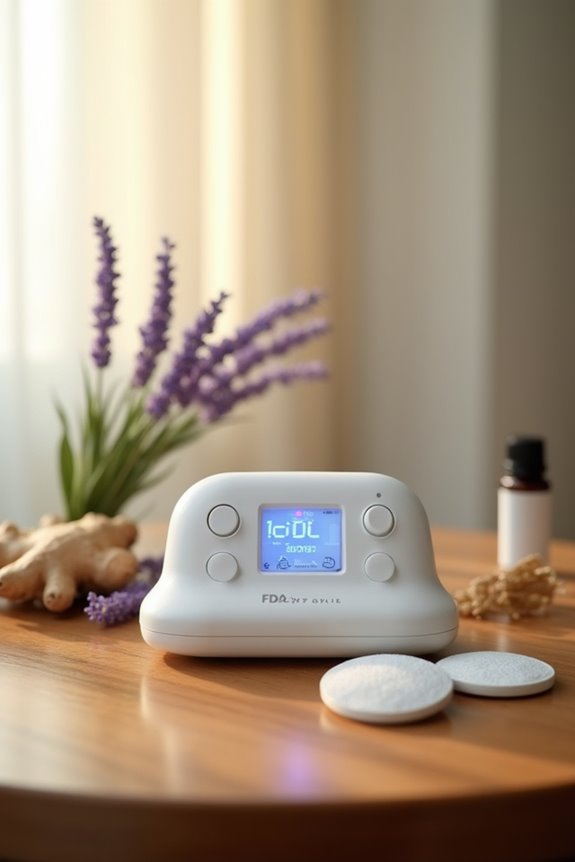
Safety and effectiveness standards are essential for ensuring that medical devices, such as TENS units, operate within acceptable parameters.
TENS Device Safety
- FDA-cleared TENS devices must meet electrical safety controls to prevent patient harm.
- Components like electrode patches come from FDA-approved suppliers, ensuring overall safety.
- Current limits vary; dental devices are restricted to 25 mA, while general units may exceed 100 mA.
- Safety testing evaluates performance under normal and fault conditions to prevent injuries.
TENS Device Effectiveness
- Manufacturers must demonstrate intended use effectiveness through clinical data in 510(k) applications.
- FDA clearance indicates substantial equivalence to devices with established safety and efficacy.
- Evidence is required for specific indications, ensuring claims align with device design and function.
Regulatory Oversight and Special Controls

Regulatory oversight for TENS devices involves stringent requirements to guarantee the safety and effectiveness of these medical instruments. Classified as Class II devices, TENS units must adhere to special controls in addition to general regulatory compliance.
Key aspects include:
- 510(k) Clearance: Manufacturers must obtain clearance indicating substantial equivalence to existing devices.
- Performance Standards: Compliance with specific performance and labeling requirements is essential.
- Special Controls: These address risks like electrical burns and shocks, emphasizing design, biocompatibility, and safety testing.
- Labeling Requirements: Clear instructions, contraindications, and safety precautions are mandated.
- Quality System Regulations (QSR): Manufacturers must follow strict quality assurance procedures throughout the device lifecycle.
Postmarket surveillance may also be required to monitor the device’s performance and any adverse events.
Market Impact of FDA Approval
How does FDA approval influence the market dynamics of TENS devices? FDA approval greatly enhances consumer trust, as it signals clinical safety and effectiveness. This trust leads healthcare providers and patients to prefer FDA-cleared devices for pain management, thereby impacting purchasing decisions.
Key Market Impacts:
- Market Differentiation: FDA-approved devices stand out in a crowded marketplace, making them more appealing to consumers.
- Access and Distribution: Retail pharmacies and clinics often require FDA clearance to stock TENS units, expanding market access.
- Insurance Reimbursement: FDA approval is essential for reimbursement opportunities, as insurers often mandate it for coverage. Additionally, high-quality adhesive pads that are FDA-approved may further enhance user satisfaction and therapy effectiveness.
Recent Regulatory Developments
Recent regulatory developments surrounding TENS devices demonstrate a significant evolution in the FDA’s approach to overseeing these technologies.
- The FDA has utilized the 510(k) clearance pathway since 1977, allowing devices to enter the market based on substantial equivalence.
- In 2021, a specific classification for neurological TENS devices was established, reflecting regulatory changes to accommodate innovative treatments.
- The de novo classification pathway has enabled newer TENS devices to gain approval without predicate equivalents, promoting device innovation.
- Notable approvals include the Cefaly device for migraine prophylaxis and the Cala ONE for acute treatment.
- The regulatory framework continues to adapt, ensuring safety while fostering advancements in TENS and neurostimulation technologies.
These developments indicate a proactive regulatory stance that supports both innovation and patient safety.
Importance of FDA Clearance for Patients
The significance of FDA clearance for TENS devices lies in its role as a benchmark for safety and effectiveness. This clearance guarantees that devices meet nationally recognized safety standards, providing numerous patient benefits, including:
- Assurance of device reliability through compliance with manufacturing practices.
- Protection against unsafe products that are not legally marketed.
- Enhanced consumer confidence in purchasing devices that adhere to federal regulations.
Additionally, FDA monitoring of adverse events and post-market surveillance reinforces patient safety, allowing healthcare providers to confidently recommend these devices. The clear regulatory framework fosters trust among practitioners, facilitating the integration of FDA-cleared TENS devices into treatment plans, ultimately benefiting patients in their pain management journeys.
Future Trends in TENS Device Regulation
As the landscape of medical technology evolves, questions arise regarding the future of TENS device regulation. The FDA’s approach is shifting towards enhanced clinical validation and specificity in device indications. Key trends include:
- Emerging Technologies: Devices like the Zynex TensWave incorporate advanced features, prompting updates in regulatory considerations.
- Clinical Evidence Requirements: Increased scrutiny may necessitate robust clinical data for new TENS devices, especially those targeting specific conditions such as ADHD and chronic migraines.
- Regulatory Pathways: The de novo 510(k) pathway illustrates a willingness to adapt, allowing innovative devices to enter the market under defined criteria.
- Post-Market Surveillance: Enhanced monitoring could guarantee long-term safety and efficacy, reflecting a commitment to patient safety in an evolving therapeutic landscape.
Frequently Asked Questions
How Do I Choose the Right TENS Device for My Needs?
When selecting a TENS device, individuals should consider features like pulse rate and intensity control, along with reputable brands. Ensuring compatibility with personal pain management goals fosters a sense of community among users seeking relief.
Can TENS Devices Be Used Alongside Other Pain Management Therapies?
Combining therapies can enhance pain relief, as TENS devices often complement physical therapy, medications, and alternative approaches. Coordination among care providers guarantees safety and effectiveness, fostering a supportive environment for best patient outcomes and comfort.
Are There Any Side Effects Associated With Using TENS Devices?
A patient using a TENS device for chronic pain experienced unexpected skin irritation, illustrating the potential risks associated with these devices. Users should be aware of side effects like discomfort, rashes, and allergic reactions when considering treatment.
How Often Can I Safely Use a TENS Device?
TENS device frequency should generally range from 15 to 60 minutes per session, depending on individual tolerance. Safe usage involves multiple sessions daily, but users must avoid skin irritation and follow manufacturer guidelines for ideal results.
Do I Need a Prescription to Purchase a TENS Device?
Prescription requirements for TENS devices vary based on regulations and intended use. Many devices are available over the counter, while others may necessitate a prescription, especially for specific medical conditions or insurance coverage needs.


